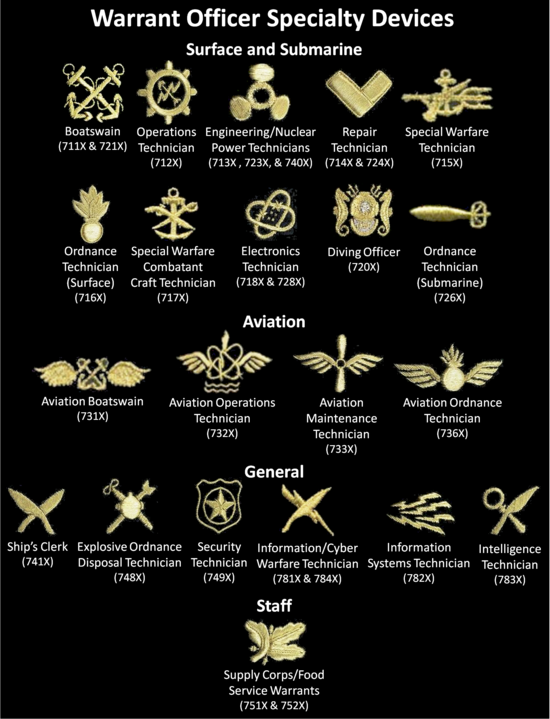Chief warrant officer is a senior warrant officer rank, used in many countries.
In the United States Armed Forces, a line officer or officer of the line is a U.S. Navy or U.S. Marine Corps commissioned officer or warrant officer who exercises general command authority and is eligible for operational command positions, as opposed to officers who normally exercise command authority only within a Navy Staff Corps. The term line officer is also used by the U.S. Air Force and U.S. Coast Guard to indicate that an officer is eligible for command of operational, viz., tactical or combat units. The term is not generally used by officers of the U.S. Army – the roughly corresponding Army terms are basic branch and special branch qualified officers, although the concepts are not entirely synonymous, as some Army special branch officers are eligible to hold command outside their branch specialty.
An unrestricted line officer is a designator given to a commissioned officer of the line in the United States Navy, who is eligible for command at sea of the navy's warfighting combatant units such as warships, submarines, aviation squadrons and SEAL teams. They are also eligible to command the higher echelons of those units, such as destroyer and submarine squadrons, air wings and air groups, and special warfare groups.
A limited duty officer (LDO) is an officer in the United States Navy or United States Marine Corps who was selected for commissioning based on skill and expertise. They are the primary manpower source for technically specific billets not best suited for traditional Unrestricted Line, Restricted Line, or Staff Corps career path officers. Per Title 10, U.S. Code, an LDO is a permanent commissioned officer appointed under section 8139 in a permanent grade above chief warrant officer, W-5, and designated for limited duty.
Commodore was an early title and later a rank in the United States Navy, United States Coast Guard and the Confederate States Navy, and also has been a rank in the United States Public Health Service Commissioned Corps and the National Oceanic and Atmospheric Administration Commissioned Officer Corps and its ancestor organizations. For over two centuries, the designation has been given varying levels of authority and formality.

In the United States Armed Forces, the ranks of warrant officer are rated as officers above all non-commissioned officers, candidates, cadets, and midshipmen, but subordinate to the lowest officer grade of O‑1. This application differs from the Commonwealth of Nations and other militaries, where warrant officers are the most senior of the other ranks, equivalent to the U.S. Armed Forces grades of E‑8 and E‑9.
In the United States uniformed services, captain is a commissioned-officer rank. In keeping with the traditions of the militaries of most nations, the rank varies between the services, being a senior rank in the naval services and a junior rank in the ground and air forces. Many fire departments and police departments in the United States also use the rank of captain as an officer in a specific unit.

This is a list of rank insignia of the United States Marine Corps. Different styles of rank insignia are worn on different marine uniforms.

The Civil Engineer Corps (CEC) is a staff corps of the United States Navy. CEC officers are professional engineers and architects, acquisitions specialists, and Seabee Combat Warfare Officers who qualify within Seabee units. They are responsible for executing and managing the planning, design, acquisition, construction, operation, and maintenance of the Navy's shore facilities. The Civil Engineer Corps is under the command of the Chief of Civil Engineers and Commander, Naval Facilities Engineering Systems Command. On 12 August 2022, RADM Dean VanderLey relieved RADM John W. Korka, becoming the 46th commander of NAVFAC and Chief of Civil Engineers.
United States Coast Guard officer rank insignia describes an officer's pay-grade. Rank is displayed on collar devices, shoulder boards, and on the sleeves of dress uniforms.

A rear admiral in the uniformed services of the United States is either of two different ranks of commissioned officers: one-star flag officers and two-star flag officers. By contrast, in most other countries, the term "rear admiral" refers only to an officer of two-star rank.
Vice admiral is a three-star commissioned officer rank in the United States Navy, the United States Coast Guard, the United States Public Health Service Commissioned Corps, and the National Oceanic and Atmospheric Administration Commissioned Officer Corps, with the pay grade of O-9. Vice admiral ranks above rear admiral and below admiral. Vice admiral is equivalent to the rank of lieutenant general in the other uniformed services.

The United States Navy has nearly 500,000 personnel, approximately a quarter of whom are in ready reserve. Of those on active duty, more than eighty percent are enlisted sailors, and around fifteen percent are commissioned officers; the rest are midshipmen of the United States Naval Academy and midshipmen of the Naval Reserve Officer Training Corps at over 180 universities around the country and officer candidates at the navy's Officer Candidate School.

An officer is a person who holds a position of authority as a member of an armed force or uniformed service.

In the United States Navy, United States Coast Guard, United States Public Health Service Commissioned Corps (USPHS), and National Oceanic and Atmospheric Administration Commissioned Officer Corps, captain is the senior-most commissioned officer rank below that of flag officer. The equivalent rank is colonel in the United States Army, Air Force, Space Force, and Marine Corps.























































